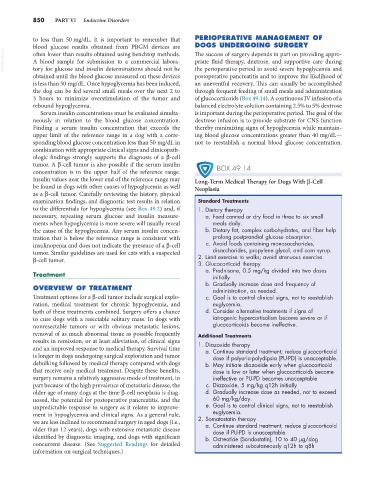Page 878 - Small Animal Internal Medicine, 6th Edition
P. 878
850 PART VI Endocrine Disorders
to less than 50 mg/dL. It is important to remember that PERIOPERATIVE MANAGEMENT OF
blood glucose results obtained from PBGM devices are DOGS UNDERGOING SURGERY
VetBooks.ir often lower than results obtained using benchtop methods. The success of surgery depends in part on providing appro-
priate fluid therapy, dextrose, and supportive care during
A blood sample for submission to a commercial labora-
tory for glucose and insulin determinations should not be
postoperative pancreatitis and to improve the likelihood of
obtained until the blood glucose measured on these devices the perioperative period to avoid severe hypoglycemia and
is less than 50 mg/dL. Once hypoglycemia has been induced, an uneventful recovery. This can usually be accomplished
the dog can be fed several small meals over the next 2 to through frequent feeding of small meals and administration
3 hours to minimize overstimulation of the tumor and of glucocorticoids (Box 49.14). A continuous IV infusion of a
rebound hypoglycemia. balanced electrolyte solution containing 2.5% to 5% dextrose
Serum insulin concentrations must be evaluated simulta- is important during the perioperative period. The goal of the
neously in relation to the blood glucose concentration. dextrose infusion is to provide substrate for CNS function
Finding a serum insulin concentration that exceeds the thereby minimizing signs of hypoglycemia while maintain-
upper limit of the reference range in a dog with a corre- ing blood glucose concentrations greater than 40 mg/dL—
sponding blood glucose concentration less than 50 mg/dL in not to reestablish a normal blood glucose concentration.
combination with appropriate clinical signs and clinicopath-
ologic findings strongly supports the diagnosis of a β-cell
tumor. A β-cell tumor is also possible if the serum insulin BOX 49.14
concentration is in the upper half of the reference range.
Insulin values near the lower end of the reference range may Long-Term Medical Therapy for Dogs With β-Cell
be found in dogs with other causes of hypoglycemia as well Neoplasia
as a β-cell tumor. Carefully reviewing the history, physical
examination findings, and diagnostic test results in relation Standard Treatments
to the differentials for hypoglycemia (see Box 49.2) and, if 1. Dietary therapy
necessary, repeating serum glucose and insulin measure- a. Feed canned or dry food in three to six small
ments when hypoglycemia is more severe will usually reveal meals daily.
the cause of the hypoglycemia. Any serum insulin concen- b. Dietary fat, complex carbohydrates, and fiber help
tration that is below the reference range is consistent with prolong postprandial glucose absorption.
insulinopenia and does not indicate the presence of a β-cell c. Avoid foods containing monosaccharides,
tumor. Similar guidelines are used for cats with a suspected disaccharides, propylene glycol, and corn syrup.
β-cell tumor. 2. Limit exercise to walks; avoid strenuous exercise.
3. Glucocorticoid therapy
a. Prednisone, 0.5 mg/kg divided into two doses
Treatment initially
b. Gradually increase dose and frequency of
OVERVIEW OF TREATMENT administration, as needed.
Treatment options for a β-cell tumor include surgical explo- c. Goal is to control clinical signs, not to reestablish
ration, medical treatment for chronic hypoglycemia, and euglycemia.
both of these treatments combined. Surgery offers a chance d. Consider alternative treatments if signs of
to cure dogs with a resectable solitary mass. In dogs with iatrogenic hypercortisolism become severe or if
nonresectable tumors or with obvious metastatic lesions, glucocorticoids become ineffective.
removal of as much abnormal tissue as possible frequently Additional Treatments
results in remission, or at least alleviation, of clinical signs 1. Diazoxide therapy
and an improved response to medical therapy. Survival time a. Continue standard treatment; reduce glucocorticoid
is longer in dogs undergoing surgical exploration and tumor dose if polyuria-polydipsia (PU-PD) is unacceptable.
debulking followed by medical therapy compared with dogs b. May initiate diazoxide early when glucocorticoid
that receive only medical treatment. Despite these benefits, dose is low or later when glucocorticoids become
surgery remains a relatively aggressive mode of treatment, in ineffective or PU-PD becomes unacceptable
part because of the high prevalence of metastatic disease, the c. Diazoxide, 5 mg/kg q12h initially
older age of many dogs at the time β-cell neoplasia is diag- d. Gradually increase dose as needed, not to exceed
nosed, the potential for postoperative pancreatitis, and the 60 mg/kg/day.
unpredictable response to surgery as it relates to improve- e. Goal is to control clinical signs, not to reestablish
ment in hypoglycemia and clinical signs. As a general rule, euglycemia.
we are less inclined to recommend surgery in aged dogs (i.e., 2. Somatostatin therapy
a. Continue standard treatment; reduce glucocorticoid
older than 12 years), dogs with extensive metastatic disease dose if PU-PD is unacceptable.
identified by diagnostic imaging, and dogs with significant b. Octreotide (Sandostatin), 10 to 40 µg/dog
concurrent disease. (See Suggested Readings for detailed administered subcutaneously q12h to q8h
information on surgical techniques.)

